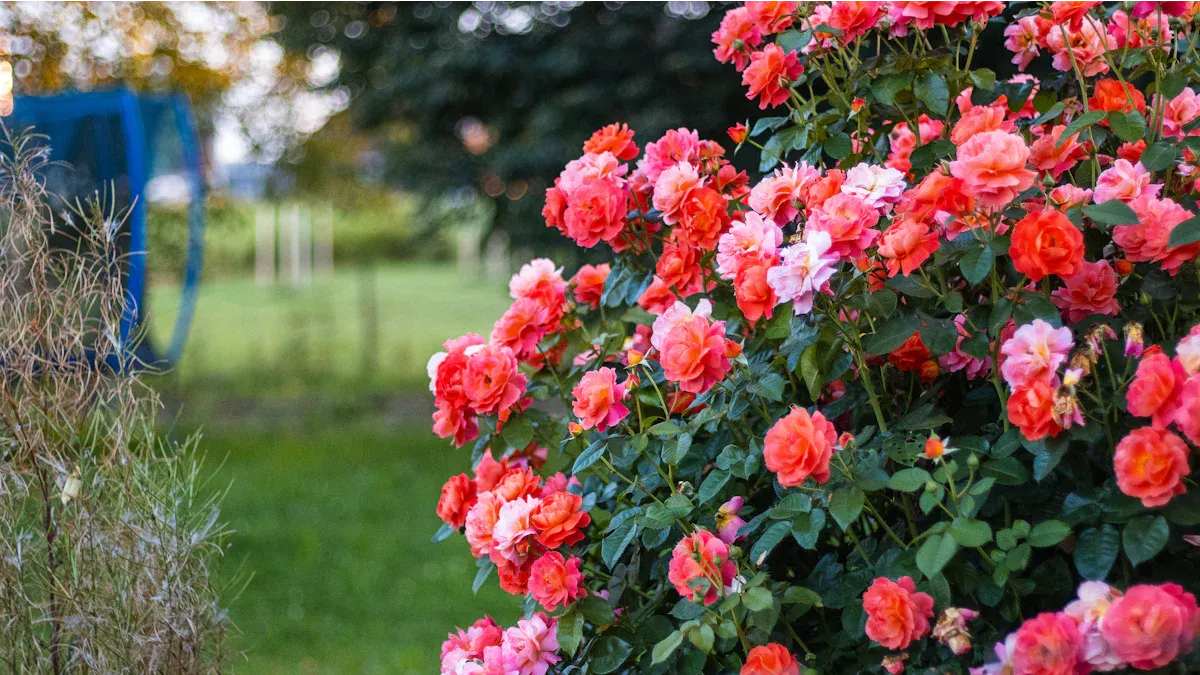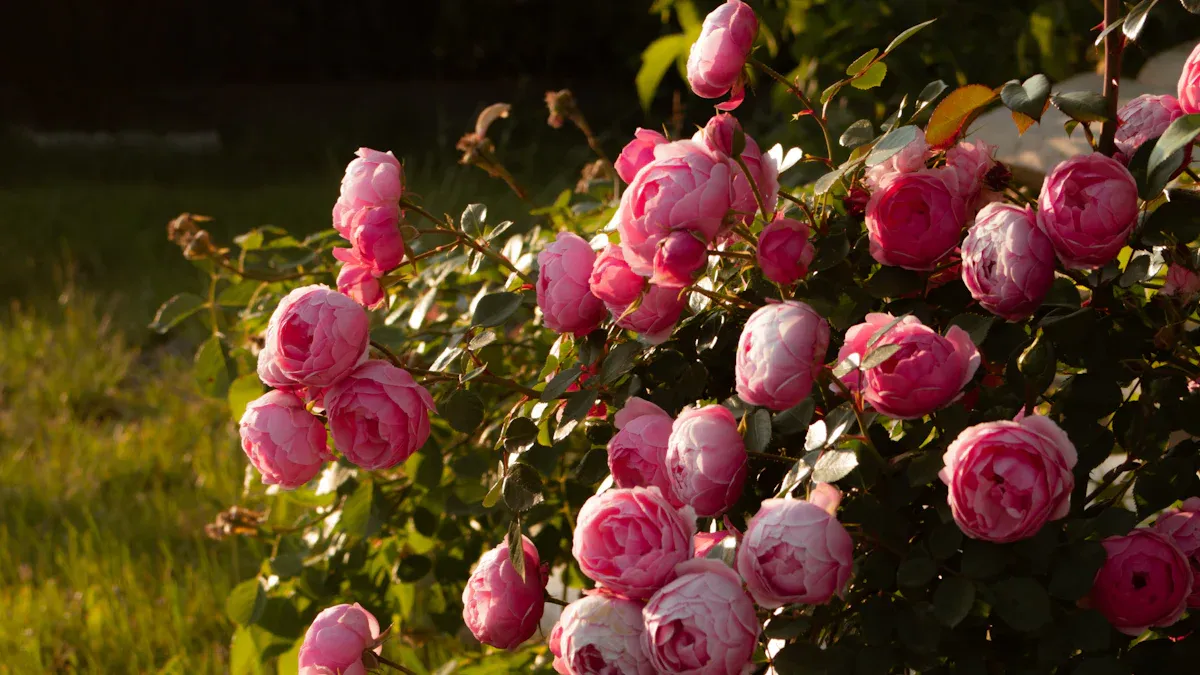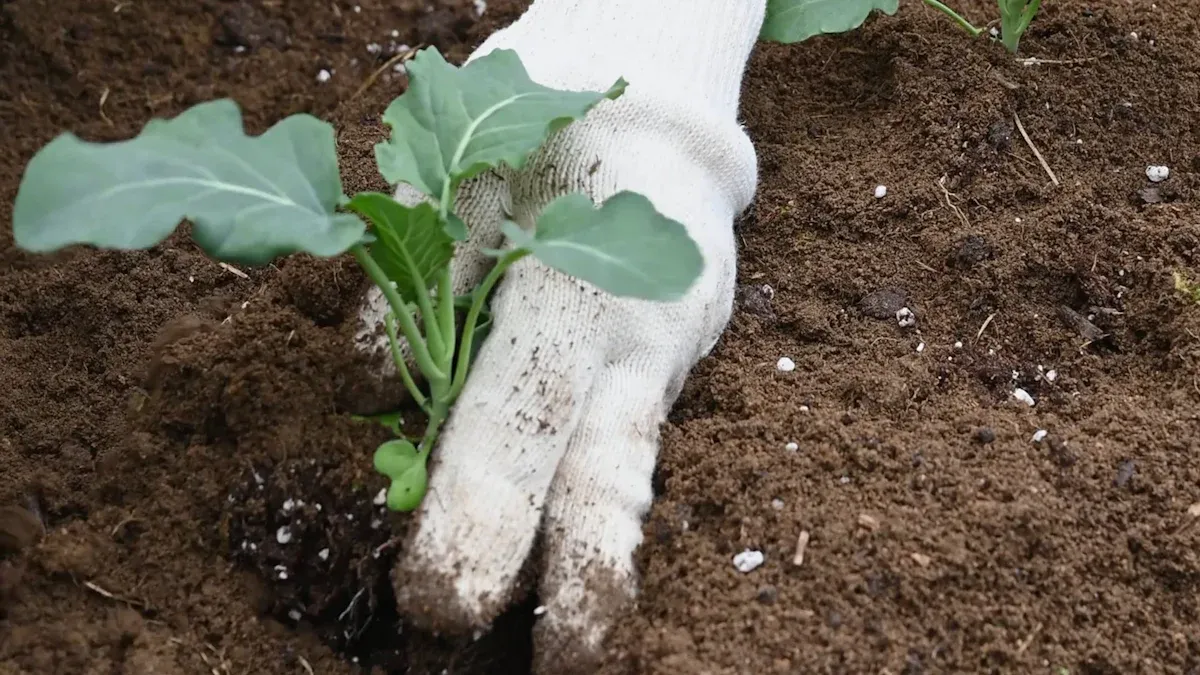
Have you ever wondered why your rose bush flowering isn’t happening? This common issue can be frustrating, but understanding the causes is key. Factors like insufficient sunlight, pests, and improper fertilization often play a role. By identifying your specific problems, you can take action to encourage beautiful rose bush flowering and enjoy your garden even more! 🌹
Key Takeaways
Ensure your rose bushes receive at least six hours of sunlight daily to promote healthy blooming.
Test and improve your soil quality by adding organic matter and adjusting pH levels for optimal nutrient absorption.
Prune your roses correctly in early spring and deadhead regularly to encourage more blooms throughout the season.
Sunlight Issues

Identifying Sunlight Problems
Sunlight plays a crucial role in the health of your rose bushes. If your roses aren’t blooming, it might be due to insufficient sunlight. Here are some signs that your rose bush isn’t getting enough sun:
Reduced flowering
Smaller blooms
Increased susceptibility to diseases due to wet foliage
Most rose bushes need at least six hours of full sun each day, preferably in the morning. Some varieties thrive with 6 to 8 hours of sunlight daily. If your roses are in a shaded area, they may struggle to produce those beautiful blooms you desire.
Solutions for Better Sunlight Exposure
To help your roses soak up the sun, consider these tips:
Relocate your roses: If possible, move your rose bushes to a sunnier spot in your garden. Aim for a location that receives at least 5 to 6 hours of direct sunlight.
Trim surrounding plants: If nearby trees or shrubs block sunlight, trim them back to allow more light to reach your roses.
Use shade cloth: If your roses are in a spot that gets too much sun, protect them with shade cloth or umbrellas. This can prevent sunburn while still allowing them to get the light they need.
Position pots wisely: If you have potted roses, place them under trees for natural shade during peak sun hours, but ensure they still receive enough light.
By ensuring your rose bushes get the right amount of sunlight, you’ll encourage them to flourish and bloom beautifully! 🌞
Soil Quality and Nutrients

Signs of Poor Soil
The condition of your soil significantly impacts your rose bush flowering. If your roses aren’t blooming as expected, poor soil quality might be the culprit. Here are some signs that indicate your soil may need attention:
Compacted soil: If the soil feels hard and dense, it can restrict root growth and water absorption.
Poor drainage: Water pooling around your roses after rain can lead to root rot and other issues.
Weed growth: An abundance of weeds can indicate nutrient imbalance or poor soil health.
Stunted growth: If your roses are growing slowly or not at all, it’s a sign that they might not be getting the nutrients they need.
To ensure your roses thrive, aim for soil that is rich in organic matter and has a pH level between 6 and 7. A pH of 6.5 is optimal for most rose varieties.
Enhancing Soil Conditions
Improving your soil can lead to healthier roses and more vibrant blooms. Here are some effective strategies to enhance soil quality:
Test your soil: Start by testing your soil’s pH and nutrient levels. You can purchase a soil testing kit or send a sample to a local extension service.
Add organic matter: Incorporate organic materials like compost or well-rotted manure into your soil. This practice improves drainage, aeration, and nutrient availability. Aim to apply 2″ to 4″ of organic matter before tilling your rose bed.
Use soil amendments: Depending on your soil test results, you may need to adjust the pH or add specific nutrients. For example:
To raise soil pH, use dolomitic or calcitic lime.
To lower soil pH, consider adding peat moss or coffee grounds.
For phosphorus, which is crucial for root growth and flowering, add bonemeal at a rate of 1 cup per plant.
Here’s a quick reference table for common nutrient deficiencies in roses:
Symptoms of Phosphorus Deficiency in Roses | Solutions to Phosphorus Deficiency |
|---|---|
Dark green leaves with a red or purple tint | Apply superphosphate or a balanced fertilizer containing phosphorus |
Purple-brown stripes and spots on leaf edges | Use one tablespoon per 10 liters of water |
Minor, narrow leaves that angle sharply from the stem | Mulch the soil with peat and mix it into the ground |
Delayed growth and weak, often blind, shoots | |
Poor root development and delayed flowering |
Additionally, remember that nutrient deficiencies often arise from poor nutrient availability rather than a lack of nutrients in the soil. Factors like overwatering and pH levels can hinder your roses’ ability to absorb essential nutrients.
By taking these steps to enhance your soil conditions, you’ll set the stage for stunning rose bush flowering. 🌹
Pruning Techniques
Recognizing Incorrect Pruning
Pruning your rose bushes is essential for encouraging healthy growth and vibrant blooms. However, improper pruning can lead to disappointing results. Here are some common mistakes you might make that can inhibit rose bush flowering:
Improper timing: Pruning at the wrong time can reduce flowering. Major pruning should happen in early spring after the last frost.
Wrong tools: Using dull or unclean pruners can damage your plants. Always use sharp, clean tools to make precise cuts.
Incorrect cuts: Cutting at the wrong angle or too far from a bud can hinder growth. Aim to cut just above a healthy bud at a 45-degree angle.
Neglecting deadheading: Failing to remove spent blooms prevents your roses from focusing energy on new flowers. This can divert the plant’s energy toward seed production instead of promoting new growth.
Leaving debris: Not cleaning up after pruning can promote disease, which negatively affects flowering.
By avoiding these mistakes, you can help your roses thrive and produce more blooms. 🌹
Best Practices for Pruning Roses
To ensure your rose bushes flourish, follow these best practices for effective pruning:
Know your timing: Major pruning should occur in early spring after the last frost. For repeat bloomers, deadhead in early and mid-summer. Stop deadheading in late summer to allow hip-bearing roses to fruit before dormancy.
Use the right technique: Different rose varieties require different pruning techniques. Here’s a quick reference table to guide you:
Rose Variety
Pruning Technique Description
Hybrid Teas, Floribundas, Grandifloras
Prune in early spring, cutting back ⅓ to ⅔ of the canes to an outside bud, reducing to 3 to 6 canes.
Repeat Blooming Modern Shrubs
Cut back main canes by half and laterals to two buds; thin out branches older than three years.
Repeat Blooming Climbing Roses
Do not prune for the first three years; after that, cut laterals to two or three buds in early spring.
Knock Out Roses®
Cut back canes to 12 inches in late winter to early spring to maintain vigorous growth.
Once Blooming Modern Shrub Roses
Prune lightly in mid-summer after flowering, focusing on shaping and thinning out.
Make clean cuts: Always cut at a 45-degree angle to promote healing and prevent water from pooling on the cut surface.
Remove dead or diseased wood: Look for any canes that are dead, damaged, or diseased. Removing these will help your rose bush focus its energy on healthy growth.
Encourage airflow: Thin out crowded areas to improve airflow. This helps reduce the risk of disease and encourages better flowering.
By following these best practices, you’ll set your rose bushes up for success and enjoy a stunning display of blooms throughout the growing season! 🌼
Pest and Disease Management
Identifying Pests and Diseases
Pests and diseases can seriously affect your rose bush flowering. Here are some common culprits you should watch out for:
Japanese beetles: These pests munch on rose blooms, often requiring multiple insecticide treatments.
Aphids: Small and often found in clusters, they suck sap from twigs and buds, weakening your plants.
Caterpillars and sawflies: They damage leaves, leading to unsightly defoliation.
Rose midges: Their larvae feed on developing shoots, causing blackened tips that can reduce blooms.
When it comes to diseases, several can hinder your roses’ ability to flower. Check out this table for some of the most common issues:
Disease Name | Description | Impact on Flowering |
|---|---|---|
Black Spot | Causes black spots on leaves and leaf drop. | Stunted growth and fewer, paler flowers. |
Powdery Mildew | Affects young leaves, causing curling and white powdery fuzz. | Reduces flowering due to stress on the plant. |
Stem Canker | Leads to brown, sunken areas on canes, resulting in cane die-off. | Results in wilting leaves and reduced blooms. |
Treatment and Prevention Strategies
To keep your roses healthy, you need effective treatment and prevention strategies. Here are some tips:
For pests: Handpick Japanese beetles and drop them into soapy water. For aphids, blast them off with a sharp stream of water or use insecticidal soap if the infestation is severe.
For diseases: Prune your roses annually to maintain vigor and remove any diseased foliage. Water early in the day to minimize leaf wetness, which can promote disease.
Additionally, consider these preventative measures:
Space your plants to allow good air movement, reducing humidity.
Choose disease-resistant rose varieties.
Fertilize based on soil tests to maintain slightly acidic soil pH.
By staying vigilant and proactive, you can enjoy vibrant rose bush flowering all season long! 🌹
Rose Bush Flowering Challenges
Importance of Deadheading
Deadheading is a crucial practice for encouraging your rose bushes to bloom more. When you remove spent blooms, you prevent the plant from wasting energy on seed production. Instead, it can focus on creating new flowers. According to David Hillock, a consumer floriculturist, this simple act can significantly boost the number of blooms your roses produce.
To maximize your deadheading efforts, follow these steps:
Gather your tools: Use hand pruners for clean cuts and thick gloves to protect against thorns.
Remember the 5-leaflet rule: Cut above the first set of five leaflets for stronger new growth.
Look for an outward-facing bud eye: Cut above a bud eye facing outward to encourage proper growth direction.
Avoid removing healthy buds and blooms: Snip faded flowers while leaving healthy ones intact.
Cut the stem at an angle: This helps prevent water accumulation and promotes better water uptake.
Don’t remove too much foliage: Retain healthy leaves to support photosynthesis and blooming.
Fertilizer Considerations
Fertilization plays a vital role in your rose bush flowering. However, using too much nitrogen can lead to problems. Excessive nitrogen can cause toxicity, disrupt nutrient uptake, and affect flowering cycles. To keep your roses healthy, consider these recommended fertilizers:
Dr. Earth Rose & Flower Fertilizer
Espoma Rose-Tone
Great Big Roses Organic Rose Food
Jobe’s Organics Rose & Flower Fertilizer Spikes
Compost
Bone meal
Fish fertilizer
Make sure to follow the instructions on the fertilizer packaging. This way, you can avoid over-fertilizing and ensure your roses get the nutrients they need without compromising their health.
By addressing deadheading and fertilizer use, you can overcome common challenges and enjoy a stunning display of rose bush flowering! 🌹
In summary, several factors can prevent your rose bushes from flowering. Here are the main causes and solutions:
Sunlight: Ensure your roses get at least six hours of sunlight daily.
Soil Quality: Test and amend your soil for better nutrients.
Pruning: Use proper techniques and timing to encourage blooms.
Pests and Diseases: Monitor regularly and treat issues promptly.
By taking these steps, you can enjoy vibrant blooms all season long! 🌹 Keep an eye on your roses and adjust your care as needed for the best results.
FAQ
What should I do if my rose bush has yellow leaves?
Yellow leaves often indicate overwatering or nutrient deficiency. Check your watering schedule and consider fertilizing with a balanced rose fertilizer. 🌱
How often should I prune my rose bushes?
You should prune your roses in early spring and deadhead throughout the growing season. This encourages new growth and more blooms! ✂️
Can I grow roses in pots?
Absolutely! Just ensure your pots have good drainage and provide enough sunlight. Regular watering and fertilizing will help them thrive. 🌼

